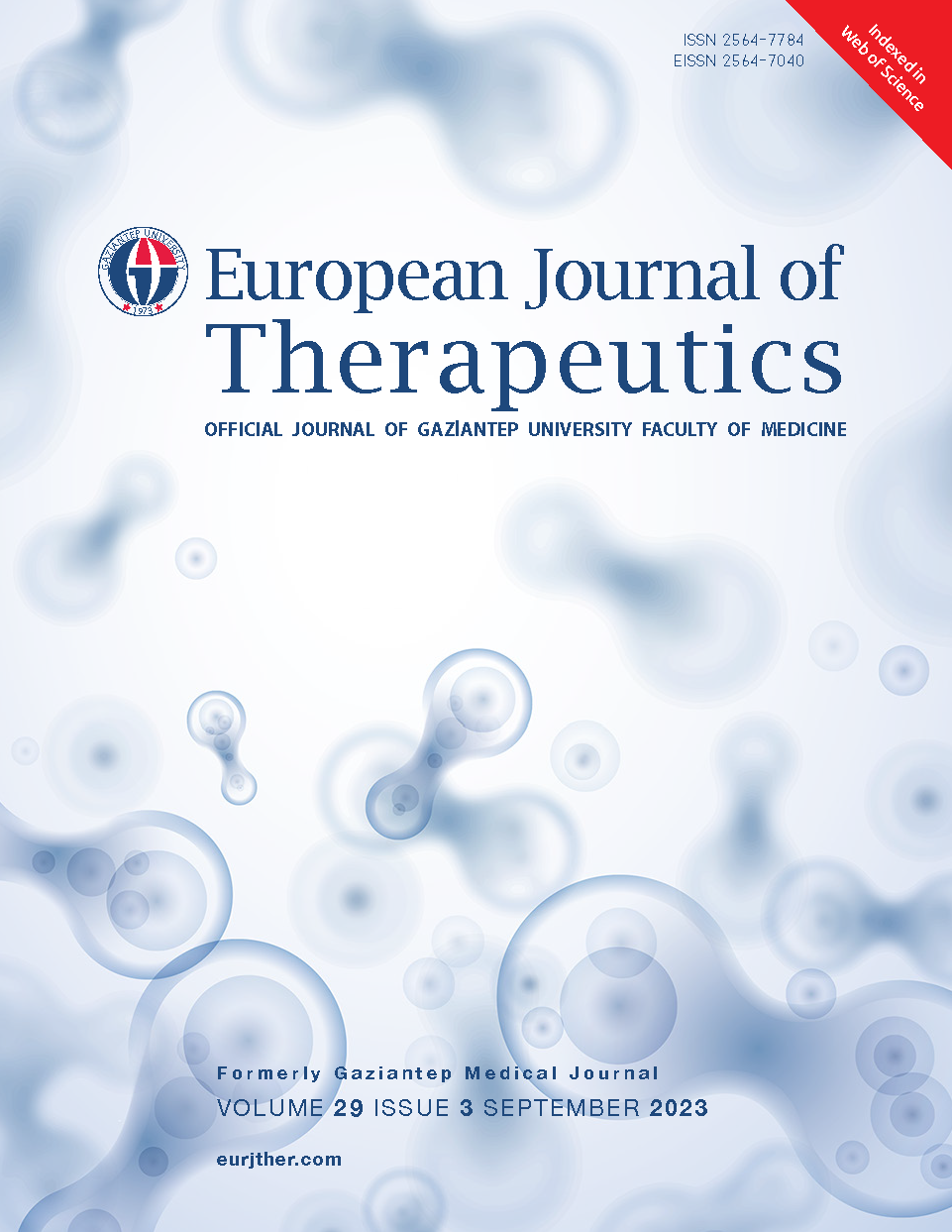Analysis of the 50 Most Cited Articles on Dabigatran: A Bibliometric Study
DOI:
https://doi.org/10.58600/eurjther1749Keywords:
Bibliometrics, dabigatran, Web of Science, citation, Hemorrhagic strokeAbstract
Objective: Atrial fibrillation (AF) is the most common cardiac arrhythmia in adults. Anticoagulation significantly reduces stroke and related mortality in AF patients. This study conducted a bibliometric analysis of the top 50 most-cited articles in the literature on dabigatran, the first new-generation oral anticoagulant.
Methods: We searched the Web of Science for articles with dabigatran in the title. The top 50 most cited articles (T50) were selected. Characteristics of the articles (such as author, source, institution, country, scientific category, number of citations, citation density, and citations per article) were analyzed.
Results: T50 had a total of 33,301 citations. The average number of citations per article was 666. The United States of America (USA) was the most prolific country in T50, with 36 papers and 26,043 citations. Wallentin Lars from Uppsala University was the most prolific author, with 14 articles and 13,532 citations. Circulation was the most prolific journal, with 11 articles.
Conclusions: We analyzed the classic publications on dabigatran, the first new-generation oral anticoagulant. The most prolific country was the USA, author was Wallentin, and journal was Circulation. Researchers and clinicians can easily access influential publications by reviewing our study.
Metrics
References
Wolf PA, Abbott RD, Kannel WB (1991) Atrial fibrillation as an independent risk factor for stroke: the Framingham Study. Stroke. 22(8): 983-8. https://doi.org/10.1161/01.str.22.8.983
Fuster V, Rydén LE, Cannom DS, et al. (2006) ACC/AHA/ESC 2006 Guidelines for the Management of Patients with Atrial Fibrillation: a report of the American College of Cardiology/American Heart Association Task Force on Practice Guidelines and the European Society of Cardiology Committee for Practice Guidelines (Writing Committee to Revise the 2001 Guidelines for the Management of Patients With Atrial Fibrillation): developed in collaboration with the European Heart Rhythm Association and the Heart Rhythm Society. Circulation. 114(7): e257-e354. https://doi.org/10.1161/CIRCULATIONAHA.106.177292
Escudero-Martínez I, Morales-Caba L, Segura T (2023) Atrial fibrillation and stroke: A review and new insights. Trends Cardiovasc Med. 33(1):23-29. https://doi.org/10.1016/j.tcm.2021.12.001
Bas DF, Topcuoglu MA, Arsava M (2013) Atrial fibrillation and stroke in the perspective of new oral anticoagulants. Turkish Journal of Cerebrovascular Diseases. 19(2): 35-45. https://doi.org/10.5505/tbdhd.2013.33042
Ruff CT, Giugliano RP, Braunwald E, et al. (2014) Comparison of the efficacy and safety of new oral anticoagulants with warfarin in patients with atrial fibrillation: a meta-analysis of randomised trials. Lancet. 383(9921): 955-62. https://doi.org/10.1016/S0140-6736(13)62343-0
Hart RG, Boop BS, Anderson DC (1995) Oral anticoagulants and intracranial hemorrhage. Facts and hypotheses. Stroke. 26(8):1471-1477. https://doi.org/10.1161/01.str.26.8.1471
January CT, Wann LS, Calkins H, et al. (2019) AHA/ACC/HRS Focused Update of the 2014 AHA/ACC/HRS Guideline for the Management of Patients With Atrial Fibrillation: A Report of the American College of Cardiology/American Heart Association Task Force on Clinical Practice Guidelines and the Heart Rhythm Society in Collaboration With the Society of Thoracic Surgeons, Circulation, 140(2): e125-e51. https://doi.org/10.1016/j.jacc.2019.01.011
Connolly SJ, Ezekowitz MD, Yusuf S, et al. (2009) Dabigatran versus warfarin in patients with atrial fibrillation, The New England journal of medicine, 361(12): 1139-1151. https://doi.org/10.1056/NEJMoa0905561
Hankey GJ (2012) Anticoagulant therapy for patients with ischaemic stroke. Nature reviews. Neurology. 8(6):319-28. https://doi.org/10.1038/nrneurol.2012.77
Tang N, Zhang W, George DM, Wei C, Su Y, Huang T (2021) The top 100 mostcited articles on arthroscopy: most popular topic is rotator cuff rather than cartilage in the last 5 years. Arthroscopy. 37(6):1779–1797. https://doi.org/10.1016/j.arthro.2021.01.039
Altunisik E, Cengiz EK, Keceli YK (2023) A bibliometric evaluation of the top 100 cited articles on ocrelizumab. Mult Scler Relat Disord. 77:104856. https://doi.org/10.1016/j.msard.2023.104856
Eyre-Walker A, Stoletzki N (2013) The assessment of science: the relative merits of post-publication review, the impact factor, and the number of citations. PLoS Biol. 11: e1001675. https://doi.org/10.1371/journal.pbio.1001675
Park KM, Park BS, Park S, Yoon DY, Bae JS (2017) Top-100 cited articles on headache disorders: A bibliometric analysis. Clin Neurol Neurosurg. 157: 40-45. https://doi.org/10.1016/j.clineuro.2017.03.022
Bahsi A, Zengin O (2021) A Bibliometric Analysis of Turkish Research Activity in the Rheumatology Category of the Web of Science Database. Eur J Ther 27(4): 299–310. https://doi.org/10.5152/eurjther.2021.21020
Bahsi I, Adanır SS, Kervancıoğlu P, Orhan M, Govsa F (2021) Bibliometric Analysis of Turkey’s Research Activity in the Anatomy and Morphology Category from the Web of Science Database. Eur J Ther 27(4): 268–280. https://doi.org/10.5152/eurjther.2021.20108
Bulut E, Dokur M, Basar E (2023) The Top 100 Cited Articles on Ocular Trauma: A Bibliometric Analysis. Eur J Ther 26(4): 322–331. https://doi.org/10.5152/eurjther.2020.19115
Xiong HY, Liu H, Wang XQ (2021) Top 100 Most-Cited Papers in Neuropathic Pain From 2000 to 2020: a Bibliometric Study. Front. Neurol. 12:765193. https://doi.org/10.3389/fneur.2021.765193
Downloads
Published
How to Cite
License
Copyright (c) 2023 European Journal of Therapeutics

This work is licensed under a Creative Commons Attribution-NonCommercial 4.0 International License.
The content of this journal is licensed under a Creative Commons Attribution-NonCommercial 4.0 International License.


















